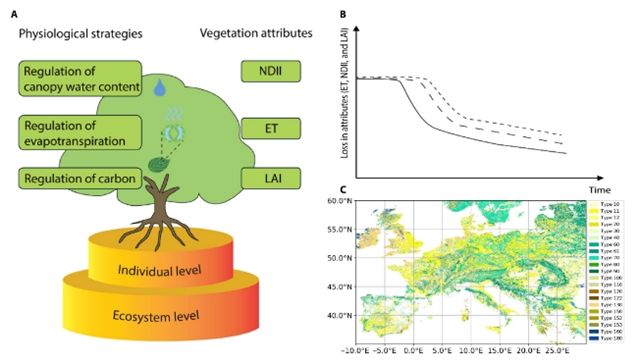
在气候变化的影响下,日益严重的干旱威胁着生态系统。多种植物生理调节过程决定了生态系统的整体抗旱性。到目前为止,这些抗旱的生理策略在不同生态系统类型的大尺度上知之甚少,因为这些生理调节过程的检测大多局限于对单个植物的原位测量。
研究组利用高分辨率遥感数据,通过评估三个关键的生理调节方面(蒸散发、水分含量和碳调节),基于它们相关的植被属性,评估了整个欧洲不同生态系统类型的干旱策略。
结果发现,不同的生态系统类型在这些生理属性上表现出不同的响应,表明在节水与耗水、含水量稳定与波动、面对干旱时保叶与脱叶方面存在不同的优化策略。这些来自遥感的干旱战略提供了及时的生态系统响应信息,促进了地球系统模型的预测,并有助于在大尺度上防范未来的干旱。
附:英文原文
Title: Revealing European-wide ecosystem strategies to drought from space
Author: Qi Chen, Joris Timmermans, Peter M. van Bodegom
Issue&Volume: 2025-08-01
Abstract: Ecosystems are threatened by increasing droughts under climate change. A multitude of plant physiological regulation processes determine the overall drought resistance of ecosystems. So far, these physiological strategies to resist drought are poorly understood at large scales across different ecosystem types because the detection of these physiological regulation processes is mostly limited to in situ measurements on individual plants. In this study, by using high-resolution remote sensing data, we evaluated drought strategies of different ecosystem types throughout Europe by evaluating three key physiological regulation aspects (evapotranspiration, water content, and carbon regulation) based on their associated vegetation attributes. We found that different ecosystem types show divergent responses in these physiological attributes, suggesting different optimization strategies with respect to water saving versus spending, water content stabilizing versus fluctuating, and leaf conserving versus shedding strategies facing drought. These drought strategies from remote sensing provide timely ecosystem response information, facilitating earth system model predictions and aiding the protection against future droughts at large scales.
DOI: adt9251
Source: https://www.science.org/doi/10.1126/sciadv.adt9251
